
Understanding the Relationship Between Size and Buttock Pain
Buttock pain can arise from a variety of causes, including musculoskeletal issues, nerve compression, and other medical conditions. The question of whether size—specifically body size or the size of the buttocks—affects buttock pain is complex and involves several factors.
Body Composition and Pain
- Weight and Pressure: Individuals with larger body sizes may experience increased pressure on their joints and soft tissues. This added weight can lead to conditions such as osteoarthritis in the hips or lower back, which can manifest as buttock pain. Increased body mass can also contribute to greater strain on muscles and ligaments in the pelvic region, potentially leading to discomfort or pain1.
- Fat Distribution: The distribution of fat in the body can influence how forces are transmitted through the pelvis and lower back. For instance, individuals with more adipose tissue in the gluteal area might have different biomechanical stresses compared to those with less fat in that region. This difference could affect muscle function and joint alignment, possibly leading to pain2.
- Muscle Strength: Larger individuals may have varying levels of muscle strength relative to their size. Weakness in key muscle groups (like the gluteal muscles) can lead to poor support for the pelvis and spine, resulting in pain3. Conversely, well-developed gluteal muscles can help stabilize the pelvis and reduce discomfort.
Activity Level
- Physical Activity: Size often correlates with activity levels; individuals who are larger may be less active due to mobility limitations or discomfort during physical activities. Reduced activity can lead to muscle atrophy and stiffness, which may exacerbate pain4. Regular movement is essential for maintaining joint health and reducing pain.
- Injury Risk: Larger individuals may also be at a higher risk for certain injuries due to biomechanics associated with their size. For example, falls or impacts during sports might result in bruising or strains that could cause buttock pain5.
Medical Conditions
- Underlying Health Issues: Conditions such as diabetes or cardiovascular diseases—which are more prevalent among individuals with higher body weights—can also contribute indirectly to buttock pain through mechanisms like neuropathy (nerve damage) or vascular issues affecting blood flow6.
- Piriformis Syndrome: This condition involves irritation of the sciatic nerve by the piriformis muscle located in the buttocks. While it is not directly related to size, individuals who sit for prolonged periods (which may correlate with larger body sizes) might develop this syndrome more frequently due to muscle tightness from inactivity7.
Conclusion
In summary, while there is no direct causal relationship established between size alone and buttock pain, various factors associated with body size—including weight distribution, muscle strength, activity level, and underlying health conditions—can influence the likelihood of experiencing buttock pain. Therefore, it is reasonable to assert that size does affect buttock pain, but this effect is mediated by multiple interconnected factors rather than being solely dependent on size itself.
Authoritative Sources
- "Pain in Buttocks" [Healthline]↩
- "Getting to the Bottom of Buttock Pain" [DrAlisonGrimaldi]↩
- "Piriformis Syndrome" [Physio-pedia]↩
- "Buttock Pain Due to Peripheral Nerve Compression or Damage" [Baltimore Peripheral Nerve Pain]↩
- "Understanding Buttock Pain" [Healthline]↩
- "Chronic Buttock Pain Causes" [Baltimore Peripheral Nerve Pain]↩
- "Piriformis Syndrome Overview" [Physio-pedia]↩

%20the%20Butt.jpeg)
Answer Provided by iAsk.ai – Ask AI.
Sign up for free to save this answer and access it later
Sign up →